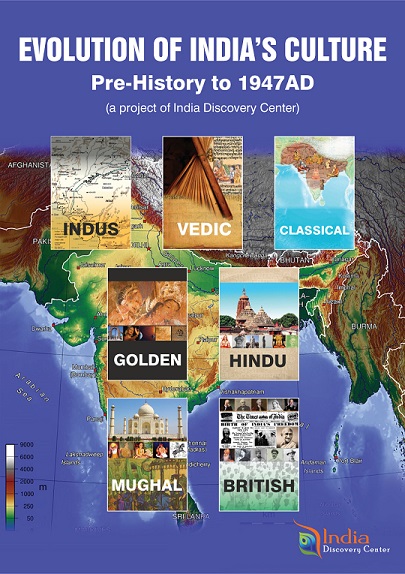Contribute
| India: Pre-history And Indus Period – Economy And Politics |
Hardik Dixit
01/28/2021
India: Pre-history and Indus Period – Economy and Politics Hardik Dixit Figure 1 – Inscription showing agricultural activity Mehrgarh in Afghanistan is a pre-Harappan site, with evidence of granaries and brick houses that indicate a technologically advanced civilization and suggest a backdrop of central administration. The economy of the Indus civilization was based on agriculture and trade, as shown by stone carvings and seals (Figure 2). The primary crops were wheat, barley and cotton. The food supply was supplemented by animal husbandry. A ploughed field at Kalibangan sheds light on use of farming. A toy plough (Figure 3) and copper tools (Figure 4) show the advanced state of agricultural technology. Farmers harvested rain for use in irrigation. The Great Granary at Harappa Mound – “F†depicts methods of storage and preservation of grains. Bullock carts were used for ground transportation, as surplus food was brought from the countryside to the cities. Figure 2 – Zebu Bull Figure 3 - Toy Plow Figure 4 – Copper Tools Trade was the second largest economic source. Most commerce was done with agricultural products such as grains and cotton, but copper, pearls, cloth and jewelry were also traded. Gold and other metals were imported. Extensive trading took place with Mesopotamia and Sumeria. Seals with the ‘Elephant’ sign were primarily used in commerce, while seals with large boats and dockyards confirm the existence of maritime trading. However, despite evidence of standardized weights and measures, there is no indication of a currency. Raw materials from Rohri hills and the southern part of India were brought in and factories converted raw materials into finished products. Unfinished shell circlets and beads made from a variety of materials suggest that these items used processing steps and were manufactured. Evidence of dyer’s workshops and samples of cotton and jute have been found, indicating that the textile production could have developed into a profitable trade. Various pottery items suggest that common householders had an artisan nature. Cities were centers for industry, craft and trade. The presence of dockyards and warehouses suggests large scale economic activity. The Harappan sites also have many open areas, as seen in Figure 5 from Shikarpur, Gujarat. Buildings with doors that face the street may have served as shops, with possible workshops or storage spaces located in the rear. Figure 5 – Open area (likely bazar) at Shikarpur, Gujarat Animal seals with images of the Zebu bull, male water buffalo, tiger and unicorn evoke an administrative hierarchy. The unique feature of these sites is the management of space in the city areas. Residences and administrative offices were in separate areas of the city. There are hints of an upper town with larger properties, and a lower area with more densely packed homes. The Citadel was the main administrative area, and an administrative body likely managed trade, taxation and food granaries. Public buildings such as great baths, granaries, citadel and city walls were likely built by the central administrative body. Waste water management was elaborate, with covered street drainage systems. Evidence has been unearthed of brick wells (Figure 6), which were likely used for fresh drinking and cooking water. Notably, no weapons have been found at any of these sites. The Indus civilization thrived on Agriculture and Trade, and the civilization also laid the foundation for efficient town planning and administration. The seals and manufacturing workshops point to a mature civilization, while the granaries and warehouses depict strong business acumen. The ancient Indus port of Lothal, recreated by the Archaeological Survey of India, is depicted in Figure 7. Figure 6- Brick well at Lothal, Gujarat Figure 7 – Lothal as envisioned by ASI Mr. Hardik Dixit leads the Economy and Politics track in India Discovery Center's project on "Evolution of Indian Culture: Pre-history to 1947AD". More information and updates on the project are available at https://www.facebook.com/Evolution-of-Indian-Culture-An-IDC-Project-107749391111922 Information on India Discovery Center is at https://www.indiadiscoverycenter.org (c) Copyright 2021 India Discovery Center, Inc. All rights reserved.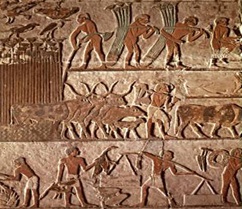 The Bhimbetka cave paintings demonstrate that community groups existed in India much before the Indus civilization. The paintings in Figure 1 show social scenes of agriculture, hunting and festivals. Animal domestication can be inferred from these images.
The Bhimbetka cave paintings demonstrate that community groups existed in India much before the Indus civilization. The paintings in Figure 1 show social scenes of agriculture, hunting and festivals. Animal domestication can be inferred from these images. 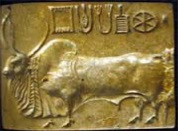
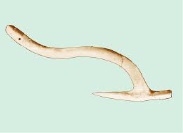
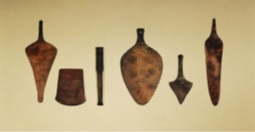

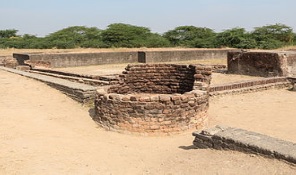
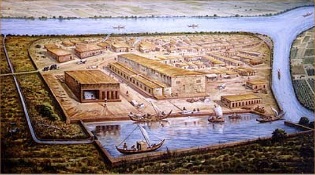
You may also access this article through our web-site http://www.lokvani.com/
